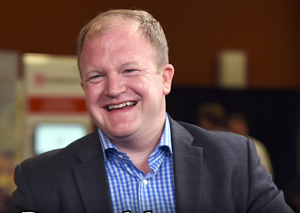Eric Reynolds, CMO at The Clorox Co., is genuine and candid with a quick smile. He oversees a huge portfolio of brands and marketing teams, making him a prolific juggler of strategies, execution plans, challenges, failures and successes.
He sat down with Chief Marketer to discuss a variety of topics from growth opportunities, to human marketing, to the three foundations for winning in today’s crazy marketing landscape.

CHIEF MARKETER: Where do you see data going in 2019?
ERIC REYNOLDS: We’ll definitely be talking about how to use data to talk to people in better, more contextually relevant ways. The buzzword is, of course, personalization, but fundamentally it’s about just getting better about acknowledging that person with more precise communications at a time that they’re open and they want it. Personalization is a significant trend, but it’s littered right now with lots of abstract ideas and concepts. I think we’ll see a more clear conversation in 2019.
CM: Where do tech providers fit in?
ER: We’re going to get the technology and data providers to respond to us and our needs rather than hoist upon us a premade solution and do a better job of listening to us and creating value for our consumers.
CM: Will the trend towards moving work in house continue next year?
ER: Clorox has had an in-house agency for 20 years, but because the world is changing we’re also changing. Every thoughtful marketing person knows that we’re looking at a future with a lot more content. There is a gap between strategic ambition and our agency’s ability to execute that. The requirements to speak to people, human beings, has changed so much that we don’t know how we can afford to do it without having an in-house agency that operates at the speed and volume that we clearly anticipate. It’s a response to that existential worry that we’re not going to be able to do it—fast and cheap.
CM: There’s a lot of discussion around human marketing. What are your thoughts?
ER: We’ll continue talking about humanity, which I care deeply about. We’re going to continue to talk about purpose-driven brands. We want a brand to stand for more than just making money, but what we realized in a time of incredible fragmentation is that we need to make sure we know who the people we serve are. And brands still need a core, a core idea that animates the imaginations of everybody who works on it and the people we seek to serve. That will rise in importance and it will be essential to hold the center.
Other articles you might enjoy:
- Marc Pritchard Calls for Stronger Action to Tackle Society and Sustainability Issues
- The New Rules of Using Feminism in Marketing
CM: What are your brand’s biggest marketing challenges or pain points?
ER: Our biggest fundamental challenge is that our consumers’ expectations of us are outstripping our ability to respond to them. That is the existential pain. They want things faster, sooner and more personalized. They want products that just aren’t one size fits all. They’re feeling this way because some manufacturers are just simply doing a better job of appealing to people’s needs and our ability to change fast enough to harness all this incredible technology and data, and brand building might is stressed.
CM: What is causing that stress?
ER: When we have more data to understand a human, a person, our marketing mix is fragmenting more. At a time when we can know a person, why are we still working in silos in many different ways? How do we continue to have integrated plans that address people’s needs on their journeys at a speed and cost that we can afford? That is an enormous pain point.
CM: Are there other factors?
ER: The other pain point is, how are we supposed to work today? How do we structure ourselves? How does work flow with all the agencies, the internal agencies, my teams? The space between a knowledgeable person and a practitioner is like a day and a half now. When I was a young man, we had playbooks that anticipated every strategic thing. Today we’re learning as we go. So restructuring to have the right talent to stitch together the data, the technology and to have people work together seamlessly is the how. We know what the answer is—smaller, more nimble teams, being agile, experimenting, being responsive to signals of intent, social listening—all that has to work extremely well in order for this new world of marketing to exist. We are a far distance from that world today. I worry that ambition outstrips our ability to change as fast.
CM: What are the biggest growth opportunities for your brand?
ER: We need to bring exceptional product innovation that meets their needs not ours. We have to create incredible times and places for engagement where consumers cannot just celebrate the benefits of our products, but also the ideas we stand for. We have to get back to the very fundamentals of this business so that we actually know what we’re doing, and when we strap on everything around it, it still has meaning. Consumers are not good at articulating what they need, but we have tools and technology, data and software that that can help us with all these questions.
CM: How does a brand like Clorox win in today’s modern landscape?
ER: Brands have to be three things that we believe are foundational.
Brands have to be human centric. We have to get to the person, the people, not generalities, not gauzy beliefs about people. We have to understand that we exist to go on their journeys, not to drag them through our paths to purchase. When we understand their journeys, and how we can be useful, we can decide how our purpose-driven strategy fits in. Second, we need to be purpose-driven. Clorox comes from a belief that brands still matter. There’s a lot of talk about whether brands matter in the data age. And then, we need to apply data technology. We have changed the way we work by pulling disciplines together not apart so that we can hold the center that no other brand stands for. We need to yoke technology and data to brands and people. Technology and data only exist to bridge the gap between brand and ideas and human beings and if it doesn’t do that it’s a distraction, it’s a noise and it’s wasting time and money.
CM: Is there a particular marketing tactic or discipline that is playing a larger role in your marketing strategy this year? Will that increase in 2019?
ER: Three of them will continue to rise, first we’re seeing see more and more content, as so many have discussed. We still believe in advertising and I would argue that advertising is content, but in that sense content is continuing to rise because the more you look at groups of people as individuals you can’t help but make more and more content. We will find our ways of placing content in more highly specific and tailored environments, which tends to mean digital. So we’re going to spend more money making sure we can put messages and engagements in contextually relevant places and our media mix will reflect that.
And, wow, has influencer marketing changed. The amount of time we spend on strategically thoughtful approaches to influencers by brand has been a sea change in the last few years. Clorox is a house of brands and there are all kinds of influencer strategies and different applications. But having other people tell our brand story as the first invitation, the first idea, is a very powerful thing. The more we invest there, the more returns we see and it’s suddenly influencing the rest of our marketing mix.
CM: What were your favorite marketing campaigns or moments of 2018?
ER: There are some campaigns out there that represent some of the trends we care about. There is the recent work by Hallmark to reframe their business from cards to care and that has been doing exceptionally well by their storytellers. Their storytelling is about other kinds of people—than white-collar guys like me —is really compelling. They way they’ve taken these stories and broken them across social, their own properties, video, it’s some of the best storytelling I’ve seen.
Another one that caught my eye was Dominos pizza. It made a commitment to filling potholes. You could say that it’s just a stunt and it probably is, but what I loved about it was Domino’s has become culturally relevant. They’re getting people to engage in the brand. That would not have been obvious 10 years ago. It would not have been seen as brand building. I’m interested in maybe not the biggest stories of the campaign year, but these things where people are trying to tell stories and leverage data and technology in truly compelling ways and create cultural tensions.
CM: How has #MeToo and the women’s movement impacted the way your company markets or operates?
ER: The #MeToo movement has emboldened us on a journey we’ve been on for a long time, but given it incredible vigor and even more momentum. When you see #MeToo come along you realize that every person— men and women—deserves dignity but we have so far to go it points out how little progress has been made. It’s not just enough to say it, words and actions have to align.


 Network
Network

